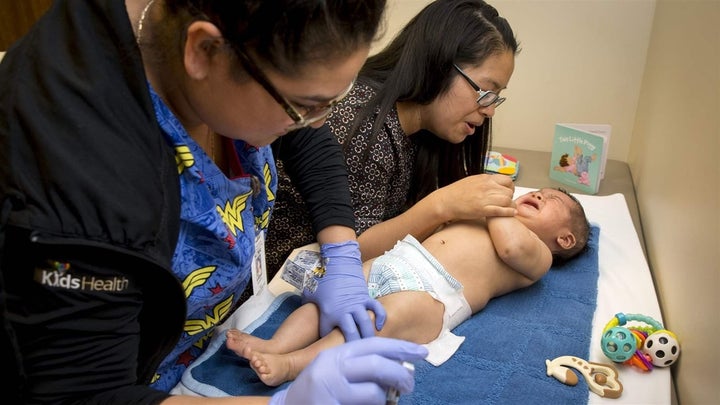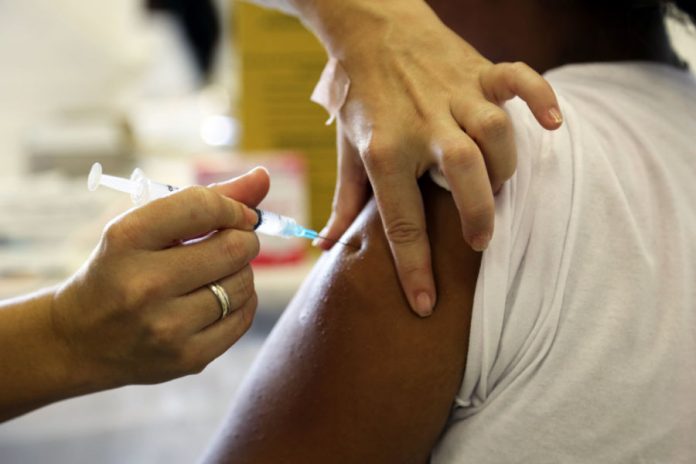A mother comforts her 6-month-old son as a medical assistant administers his immunizations in Springfield, Oregon, last month. Five states are working with the Centers for Disease Control and Prevention to improve vaccination rates.

Fresh five-state venture subsidized by the government means to enhance inoculation rates among low-pay kids and pregnant ladies, utilizing statewide vaults proposed to track the vaccination chronicles all things considered.
The expectation is that better approaches for gathering and breaking down information recognized amid the task, in the long run, will spread to all states.
The $880,000, three-year U.S. Communities for Disease Control and Prevention exertion in Colorado, Hawaii, Kentucky, Montana, and New Mexico faces various deterrents, including protection and innovative issues.
However, general wellbeing authorities are idealistic that inoculation libraries, which are as of now operational to different degrees in all states with the exception of New Hampshire — which is propelling one — can help lessen the variations in immunization rates in light of salary, geology, and race or ethnicity. Authorities might want to not just distinguish patients who are expected for inoculations, yet in addition to uncovering populace bunches whose vaccination rates could be enhanced utilizing focused on crusades.
The undertaking intends to do that with kids and pregnant ladies in Medicaid. Also, the strategies it uncovers may empower vaults to be utilized as an instrument to guarantee that all Americans are state-of-the-art in their immunizations.
To accomplish that, in any case, states need to build up a system of advanced frameworks able to do better speaking with one another so a state vaccination data framework can get inoculation information from any individual who directs antibodies — clinicians, retail wellbeing facilities, healing centers, drug stores, even schools — and over different payers, for example, protection bearers and Medicaid.
“There’s such a great amount of chance for data to be in an excessive number of better places and never collected,” said Jill Rosenthal, a senior program chief at the National Academy for State Health Policy, which is giving specialized and approach support to the task.
A kid, for example, could get an inoculation at school or a retail center, and the youngster’s specialist would have no chance to get off knowing. The outcome, Rosenthal stated, is that medicinal suppliers are left with holes in data about which immunizations patients have gotten.
20% of youngsters have been to in excess of one human services supplier by the age of 2, government information appears, bringing about scattered restorative records.
Inoculation Disparities
U.S. inoculation rates for suggested antibodies stay high, yet insights demonstrate that inconsistencies hold on between rates of youthful kids on Medicaid and children with privacy protection. The rates are brought down still among kids without protection.
The inconsistencies exist crosswise over various sorts of suggested immunizations, including those for polio; diphtheria, lockjaw and acellular pertussis (known as DTaP); measles, mumps, and rubella (MMR); and pneumococcal conjugate antibody (PCV).
For instance, among youngsters 19 to 35 months old, the inoculation rate for rotavirus — a main source of the runs in babies and kids that can prompt hospitalization and even passing — is 69 percent for children in Medicaid programs contrasted and 81 percent for those secured by private protection.
The dissimilarity is likewise substantial for pregnant ladies. In the 2016 to 2017 influenza season, 48 percent of hopeful moms on open protection (quite often Medicaid) got this season’s flu virus immunization contrasted and 59 percent for private and military protection.
The five-state venture is centered around enhancing vaccination rates for youngsters and pregnant ladies in Medicaid.
The undertaking plans to associate Medicaid data frameworks with their state’s inoculation vaults in a way that will eventually prompt increments in vaccination rates among the objective populace. The expectation is to uncover techniques that will be valuable past these populaces.
The government financing goes not specifically to the states but rather to the experts — the National Academy for State Health Policy and Academy Health, a wellbeing administrations asset focus — working with them to expand inoculation rates in the focused on the populace.
Rosenthal, with the wellbeing strategy gathering, said each state will set its own needs however that the assets will by and large be utilized to adjust Medicaid and inoculation data framework to distinguish inoculation holes and to enhance immunization rates.
Authorities likewise would like to in the long run distinguish foundational explanations behind vaccination holes: Are suppliers in a zone not exceptional on current inoculation suggestions? Is there deficient access to antibodies in certain geographic zones? Are there open doors for focused instructive battles?
The trading of data between the information frameworks is especially essential for achieving pregnant ladies. “On the off chance that a lady was pregnant, we wouldn’t know it” through our framework, said Bekki Wehner, Montana’s inoculation program supervisor. “With an association with Medicaid, we will have the capacity to recognize that populace and make a vaccination system for them.”
Reporting Gaps
States originally began inoculation libraries in the late 1980s, despite the fact that in the good ‘old days they were limited to urban areas or provinces. California, for instance, had no less than nine distinct vaults covering diverse parts of the state, as per Robert Schechter, a restorative officer with the California Department of Public Health.The vaults, which are secret, at that point were, for the most part, planned to track vaccinations among youngsters. Just in the most recent decade or so have the libraries widened to incorporate everybody.
They have confronted heap challenges en route. Albeit numerous suppliers keep electronic records, not all do, said Jan Hicks-Thomson, a general wellbeing examiner with the CDC’s vaccination data framework bolster branch. Furthermore, not all have frameworks fit for exchanging records to vaults.
A greater deterrent is that few states expect suppliers to report vaccinations. Twenty-two states don’t have obligatory revealing necessities, a recent report in the Journal of Public Health Management and Practice found. A few states, including Montana, require parental consent before experts can share inoculation data on kids. By the by, Wehner said Montana’s library has inoculation records on 97 percent of little children in the state.
Another complexity is a government training privacy law that forestalls many school-based wellbeing facilities from sharing vaccination records with outside organizations. (A general wellbeing exclusion from HIPAA, the government wellbeing security assurance act, enables other restorative suppliers to impart immunization data to vaults.)
CDC rules for inoculation vaults suggest that the data gathered be kept secret. State laws building up libraries spread out data sharing and security prerequisites.
Inspiring suppliers to gather adequate data likewise can be tricky. Libraries can be utilized for statistic examination, such as contemplating vaccination by race and ethnicity. Yet, to do as such, authorities require clinicians to gather and present that data. “Regularly, suppliers don’t catch that data,” Hicks-Thomson said.
Regardless of the holes, in any case, supporters tout the vaults for adding to the, for the most part, high inoculation rates in the nation. A considerable lot of the frameworks incorporate a “remind and review” work that cautions suppliers about patients who are expected to get a vaccination, so their workplaces can contact those patients.
Frameworks likewise regularly can give information to specialists so they can assess their consistency on immunizations. Authorities can likewise make projections to guarantee that their state has adequate measurements close by.
While the undertaking is intended for a subset of Medicaid recipients, Rebecca Coyle, official chief of the American Immunization Registry Association, which is likewise giving specialized help to the task, will recognize strategies and information control that will help vaccination libraries the nation over boost the frameworks to accomplish much higher inoculation rates for all.
“What we will have the capacity to do, the sky’s the cutoff,” she said.










